Introduction:
Our secondary school was initially designed as middle school but changed shortly after opening to a grade 8-12 secondary school with a current enrollment of approximately 900 students. The learning commons has evolved over the years to include a partitioned classroom, makerspace, Lego wall and computer terminals in addition to the various workspaces which include traditional table arrangements, beanbags and cushioned armchairs. This has all been designed to maximize a constrained space for both functional usability and aesthetics. Our reference section of texts represents a small section within the space. Noticeably, many of the encyclopedia, science, history and geography volumes are 15+ years old, with newer sources gradually being added. The online references are supported through our district ERAC Bundle, with additional subscriptions provided through the school’s learning commons. For this assignment, there were many subject specific encyclopedia volumes to focus on, but the area that I feel needs the most weeding and updating falls within the 910 Dewey area of the reference section – The Encyclopedia of World Geography, 2nd Edition.
Part 1 – Evaluative Review and Rubric of a resource
Riedling states that “encyclopedias remain essential reference sources for any student at the beginning of the information inquiry process.” (Riedling, 2019, p. 66). She further explores the conundrum faced by librarians that has them weighing cost with currency. With respect to geographical texts, as “human society has become more global than ever before; therefore, recent geographical resources are a necessity.” (Riedling, 2019, p. 75) Currency is essential for geographical texts to hold accuracy and relevance. In developing a framework for my rubric to evaluate an encyclopedia with a geography subject, I compared models explored by Riedling in Reference Skills for the School Librarian, CREW: A Weeding Manual for Modern Libraries, and ERAC’s Evaluating, Selecting and Acquiring Learning Resources: A Guide. 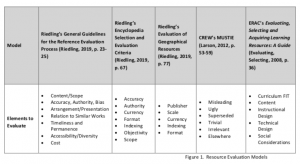 Riedling’s criteria for evaluating a reference with respect to the general guidelines becomes more streamlined with the types of resources evaluated. The criteria within the evaluation structure, however, is largely tailored to the acquisition of resources. When constructing an evaluative rubric, one that fits both weeding and acquisition needs to be designed. Therefore, the inclusion of criterion from CREW’s MUSTIE evaluation for weeding is integral to my designed rubric. ERAC’s evaluation guides also inspired my designed rubric, due to the curricular focus components.
Riedling’s criteria for evaluating a reference with respect to the general guidelines becomes more streamlined with the types of resources evaluated. The criteria within the evaluation structure, however, is largely tailored to the acquisition of resources. When constructing an evaluative rubric, one that fits both weeding and acquisition needs to be designed. Therefore, the inclusion of criterion from CREW’s MUSTIE evaluation for weeding is integral to my designed rubric. ERAC’s evaluation guides also inspired my designed rubric, due to the curricular focus components.
The Rubric
Reference Source Evaluation
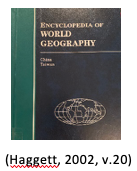
The Encyclopedia of World Geography, 2nd Edition
The next step of the reference evaluation is determining whether The Encyclopedia of World Geography, 2nd Edition meets criteria that justifies weeding and selecting a replacement. The Encyclopedia is a 24-volume set, published in 2002 by Marshall Cavendish. Using the rubric from Figure 2, the resource was evaluated, with the omission of cost as inapplicable, and it was ascertained The Encyclopedia of World Geography, 2nd Edition is an unsatisfactory reference resource.
The Encyclopedia of World Geography, 2nd Edition against the rubric
When selecting The Encyclopedia of World Geography, 2nd Edition, it was not unexpected that it would successfully meet the criteria for a ‘weedable’ reference text. When considering curriculum FIT, the number of courses using the text and whether the new curriculum was adequately supported by the content was the first evaluation undertaken. The representation of the Canadian arctic and dated terminology of “Native Indians” (Haggett, 2002, Vol 3, p. 394), is not in keeping with curriculum overview of Aboriginal Perspectives and Knowledge, which states:
“British Columbia has long had the goal of improving school success for all Aboriginal students. Achieving this goal will require that the voice of Aboriginal people be heard in all aspects of the education system; the presence of Aboriginal languages, cultures, and histories be increased in provincial curricula; and leadership and informed practice be provided.” (“Curriculum Overview”, n.d.)
The dated representation of indigenous peoples in the text is harmful to the First Peoples Principles of Learning. After exploring more volumes, it was clear to see that the fundamental reason this encyclopedia set needs to be weeded is because it is outdated and, in some sections, misinforms. Volume 15 explores the Middle East with very dated perspectives on Syria before the civil war and before ISIS. Equally this is similar with Volume 21 about South East Asia and its description of the conflicts in Burma with Aung San Suu Kyi’s recent release from house arrest and her restrictions on political freedom. (Haggett, 2002, vol 21, p. 2892)
Part 2 – Find, select, and evaluate a potential resource replacement:
Once weeding was decided, the next question soon became – will this text be replaced by another encyclopedia text volume? Online encyclopedia? Or a combination? I reached out to our vendors and evaluated 3 different potential replacements: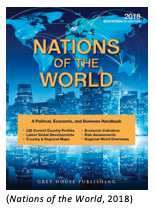
-
Nations of the World, 2018;
-
- One Volume that explores 235 Nations in limited detail.
- Sample pages on Australia demonstrate general economy and political background, but it doesn’t delve into the territories, and it only briefly mentions indigenous peoples, glossing over land claim and social issues. Limited perspective in sample. (Nations of the World, 2018, p. 103-117)
- Briefly touches on current political and economic events
- Online access – Non IP Authenticated, enabling remote login access
- One language
- Quote: $240.00 CAD (quote provided by representative at Salem Press)
- Evaluation Result: Ruled out – Content/Scope is lacking for this to be a replacement resource.
- One Volume that explores 235 Nations in limited detail.
-
-
CultureGrams (CultureGrams Data, n.d., p. 1)
-
- Online access only. Offsite login access ability
- English only, but reads aloud content for accessibility (“Antarctica”, 2020)
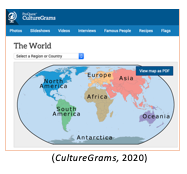
- Provides: “local perspectives on more than 200 countries, detailing daily life and culture, including history, customs, and lifestyles. From Afghanistan to Zimbabwe, each concise, reliable, and up-to-date report is written and reviewed by local experts, providing users with unique, intimate cultural details from a real insider’s perspective.” (CultureGrams Data, n.d., p. 1)
- Quote: $977.53 USD/12 months (quote provided by ProQuest and based on 900 students)
- Evaluation: Ruled out – after evaluating the online trial, the content and scope was appropriate, but the cost justification was off balance. A yearly expenditure of this size would not proportionately reflect student needs.
-
-
World Geography, Second Edition, 2020;
-
- 6 volume set explores:
- Per vendor, some language toggle ability
- Free online access – non-IP authenticated. Login access offsite.
- Quote: $793.33 CAD (Quote provided by representative at Salem Press)
- Evaluation Result per the rubric below: Good option to serve as replacement; however, an online trial is not available until September 2020 and before a purchase, this would need further evaluation.
-
World Geography, Second Edition, 2020 against the rubric
Concluding Remarks:
The resource that supports my school’s need isn’t necessarily the best resource evaluated. When considering replacing a multi-volume set from the reference section, the most ideal replacement is a text/online combo. Many of the coursework assignments that the learning commons supports require students to access books and online resources. In every source I evaluated, the Canadian perspective was lacking, but within topic of World Geography, most of the material is published in the US. This impacts Canadian perspective, but potentially also the accessibility for multi-language use, particularly in French. Another mitigating factor is cost. A one-time expenditure versus yearly one heavily weighs in the ruling out of a resource like Culture Grams. Having said this, were this to be a part of our district’s ERAC bundle, then the emphasis of having an onsite book would be weighed less in my evaluation. Cost is a key driver in the evaluation process.
World Geography, 2nd Edition offers better support of the new curriculum with its currency. The outdated ‘facts’ and archaic terminology justifies the weeding of The Encyclopedia of World Geography, 2nd Edition. Because of the newly updated content World Geography, 2nd Edition, however, senior level courses such as Comparative Cultures 12 and Physical Geography 12 will have more opportunities for students to connect with the text and online material. The updated content explores through country specific presentation perspectives of past and present cultures, which is a key curricular competency for Comparative Cultures 12. (“Comparative Cultures”, n.d.) Additionally, the text’s topical coverage of regional breakdown, physical geography, biogeography and natural resources support the assessment of how human and environmental factors and events influence each other, a key curricular competency for Physical Geography 12 (“Physical Geography”, n.d).
The format and indexing of World Geography, 2nd Edition is comparable to The Encyclopedia of World Geography, 2nd Edition, except for content amounts. The Encyclopedia is 25 volumes versus 6 and includes one exclusive index textbook. There is a reduction in the amount of content/detail, but the value of currency outweighs in this instance. The final evaluation, which I was unfortunately unable to undertake will be to request the online access component in September, when it is available. This will enable a more comprehensive assessment of user friendliness and the format/technical design. Overall, World Geography 2nd Edition, received a positive evaluation due to cost, currency, format variety and curriculum FIT.
Works Cited:
“Antarctica” (2020). CultureGrams Online Edition. ProQuest. Retrieved from http://online.culturegrams.com/famouspeople/country.php?contid=13&cid=236&wmn=Antarctica&type=World
Comparative Cultures 12. (n.d.). Retrieved February 4, 2020, from BC’s New Curriculum website: https://curriculum.gov.bc.ca/curriculum/social-studies/12/comparative-cultures
CultureGrams Data Sheet [Pamphlet]. (n.d.). ProQuest.
Curriculum Overview. (n.d.). Retrieved February 3, 2020, from BC’s New Curriculum website: https://curriculum.gov.bc.ca/curriculum/overview
Evaluating, Selecting and Acquiring Learning Resources: A Guide [Guide]. (2008). Retrieved from https://bcerac.ca/wp-content/uploads/2018/09/ERAC_WB.pdf
Haggett, P. (2002). Encyclopedia of world geography (2nd ed.). New York, NY/USA: Marshall Cavendish.
Larson, J. (2012). CREW: A Weeding Manual for Modern Libraries [Manual]. Retrieved from https://www.tsl.texas.gov/sites/default/files/public/tslac/ld/ld/pubs/crew/crewmethod12.pdf
Nations of the World. (2018). Retrieved from https://greyhouse.com/Media/GreyHousePublishing/samples/nations_pgs.pdf
Physical Geography 12. (n.d.). Retrieved February 4, 2020, from BC’s New Curriculum website: https://curriculum.gov.bc.ca/curriculum/social-studies/12/physical-geography
Proquest Libguides CultureGrams. (2019) Retrieved February 8, 2020 from http://proquest.libguides.com/culturegrams
Riedling, A. M., & Houston, C. (2019). Reference skills for the school librarian: Tools and tips (4th ed.). Santa Barbara, CA: Libraries Unlimited.
World Geography. (n.d.). Retrieved February 4, 2020, from Salem Press website: https://www.salempress.com/book/world-geography

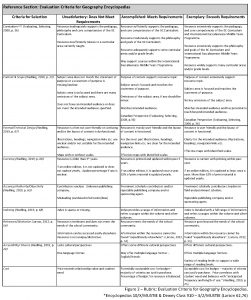
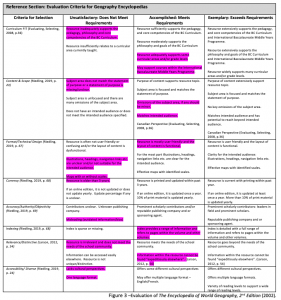

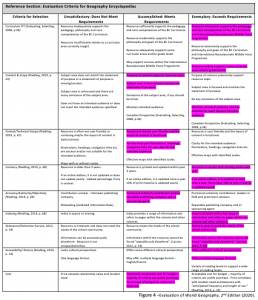
 Follow
Follow
I appreciate the fact that the reference source that you ultimately selected is not necessarily the “best” in terms of evaluation – but it best suits the needs of your learning community. The fact that you recognized that is commendable. I too found that the majority of resources pertaining to geography were printed in the United States rather than Canada. Ultimately, the resource that I weeded was Canadian and it was replaced with an American resource as well.